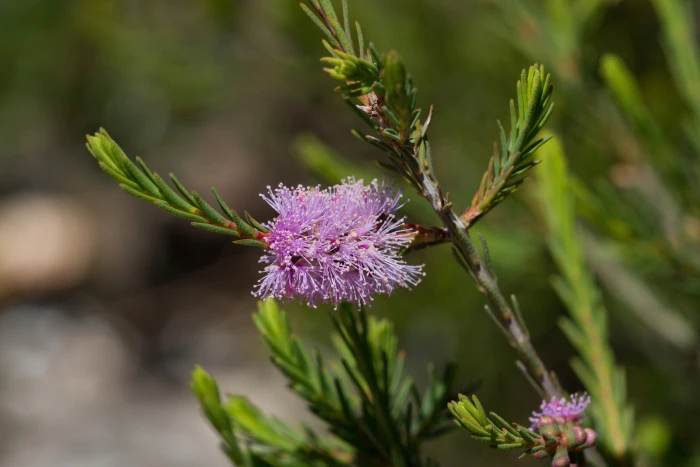Cross-Leaf Honey Myrtle
(Melaleuca decussata)
Cross-Leaf Honey Myrtle (Melaleuca decussata)
/
/

Kym Nicolson
CC BY 4.0
Image By:
Kym Nicolson
Recorded By:
Copyright:
CC BY 4.0
Copyright Notice:
Photo by: Kym Nicolson | License Type: CC BY 4.0 | License URL: http://creativecommons.org/licenses/by/4.0/ | Occurence ID: https://www.gbif.org/occurrence/1632959619 | Publisher: Atlas of Living Australia |

































Estimated Native Range
Climate Requirements
| • Precipitation | 12" - 50" |
| • High Temp. | 70°F - 93°F |
| • Low Temp. | 3°F - 48°F |
Summary
Melaleuca decussata, commonly known as Cross-Leaf Honey Myrtle, is an evergreen shrub native to the open woodlands and coastal heaths of Southern Australia. It typically grows to a height and width of 3 meters (10 feet), featuring a dense branching habit. The foliage is characterized by its cross-like arrangement, which is where the common name is derived from. Flowers are showy, starting as a shade of pink or purple before fading to white, and are arranged in spikes at the ends of branches, which continue to grow after flowering, and on the sides of the branches. The main flowering season extends from August to May, peaking from November to February. Following the flowers, woody capsules form, fused at their bases and embedded in the stem, which are notable for their unique appearance.
Cross-Leaf Honey Myrtle is valued for its hardiness and attractive foliage, making it a versatile addition to gardens. It provides year-round interest with its mauve-colored flowers, although they are short-lived in their initial vibrant color. This species is suitable for a variety of uses, including as a feature plant, in mixed shrub borders, or as informal screening. It is tolerant of a range of conditions but prefers full sun to part shade, low to medium water, and well-drained soils. Gardeners should be cautious about planting it near wastewater pipes due to its potential to cause damage with its roots.CC BY-SA 4.0
Cross-Leaf Honey Myrtle is valued for its hardiness and attractive foliage, making it a versatile addition to gardens. It provides year-round interest with its mauve-colored flowers, although they are short-lived in their initial vibrant color. This species is suitable for a variety of uses, including as a feature plant, in mixed shrub borders, or as informal screening. It is tolerant of a range of conditions but prefers full sun to part shade, low to medium water, and well-drained soils. Gardeners should be cautious about planting it near wastewater pipes due to its potential to cause damage with its roots.CC BY-SA 4.0
Plant Description
- Plant Type: Shrub
- Height: 10-15 feet
- Width: 4-6 feet
- Growth Rate: Rapid
- Flower Color: Purple, Pink, White
- Flowering Season: Spring, Summer
- Leaf Retention: Evergreen
Growth Requirements
- Sun: Full Sun, Part Shade
- Water: Low, Medium
- Drainage: Fast
Common Uses
Bee Garden, Bird Garden, Butterfly Garden, Hedges, Hummingbird Garden, Low Maintenance, Showy Flowers, Street Planting
Natural Habitat
native to the open woodlands and coastal heaths of Southern Australia
Other Names
Common Names: Totem Poles
Scientific Names: Melaleuca decussata, Melaleuca parviflora, Melaleuca affinis, Melaleuca decussata var. ovoidea, Melaleuca elegans, Melaleuca oligantha, Melaleuca pumila, Melaleuca tetragona, Myrtoleucodendron decussatum
GBIF Accepted Name: Melaleuca decussata R.Br.